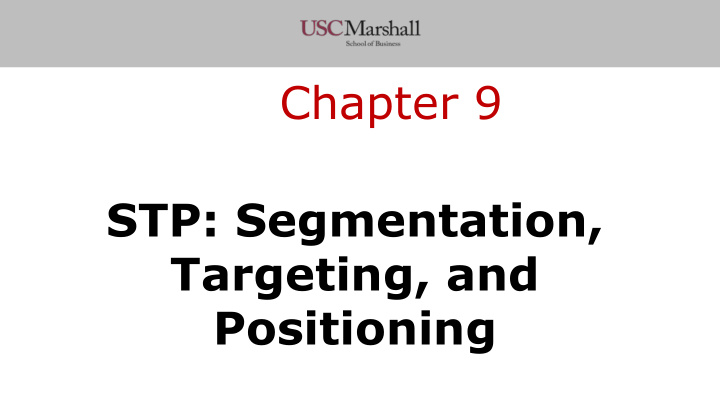



Chapter 9 STP: Segmentation, Targeting, and Positioning
Today • Outline the different methods of segmenting a market • Describe how firms determine whether a segment is attractive and therefore worth pursuing • Articulate the differences among targeting strategies: undifferentiated, differentiated, concentrated, or micromarketing • Define positioning and describe how firms do it 2
The big picture Competition Marketing Macroenv. analysis factors Corporate (understanding Company CONSUMERS partners your business) Segment Targeting Positioning Creating value Place Promotion Product Capturing Price value Customer retention Customer acquisition PROFIT 3
STP Process Important for group projects 4
Step 1: Establish overall vision or objectives for your marketing strategy Segmentation strategy MUST be consistent with – Firm’s mission/objective – Firm’s current situation (SWOT) 5
Step 1: Establish Overall Vision or Objectives for your Marketing Strategy Segmentation strategy MUST be consistent with – Firm’s mission/objective – Firm’s current situation (SWOT) “Coca-Cola’s objective is to increase sales in a mature industry.” If this is our objective: 1. What research should we be doing about our consumer? 2. Who is our consumer? 3. What benefits is he/she seeking? The above questions lead you through the STP process. 6
Step 2: Segmentation Methods Segmentation is the process of dividing the market in segments 1. Identify segments 2. Describe segments à Helps the firms better understand different consumers profiles and similarities across segments 7
Step 2: Segmentation Methods Segmentation How consumers are divided? Sample Segments Method Continent: North America, Asia, Europe, Africa. Within the United Depending on their geographical Geographic location States: Pacific, mountain, central, south, mid-Atlantic, northeast Depending on their demographic Demographic Age, gender, income information Depending on how consumers Psychographic Lifestyle, self-values, self-image describe/think about themselves Depending on the benefits they Benefits Convenience, economy, prestige derive from the product or service Depending on how they use the Behavioral Occasion, loyalty product or service 8
Step 2: Segmentation Methods Geographic Segmentation • Consumers organized on the basis of where they live https://www.youtube.com/watch?v=6Pkq_eBHXJ4 9
Step 2: Segmentation Methods 10
Step 2: Segmentation Methods Psychographic Segmentation • Consumers organized on the basis of lifestyle and values 11
Step 2: Segmentation Methods Behavioral Segmentation • Consumers organized on the basis of how they use the product/service 12
STP 14
Targeting Targeting is the process of selecting the market segment(s) to which the firm would like to sell their products or services 15
Step 3: Evaluate Segment Attractiveness 16
Step 3: Evaluate Segment Attractiveness Identifiable Which consumers are in the segment? • Are the segments distinct from one another? • Does each segment require a unique marketing mix? • 17
Step 3: Evaluate Segment Attractiveness Substantial Too small à Not enough profit • Too big à it may be impossible to craft a message that resonates equally • with all the members of your chosen segment Effective segmentation is critical for the success of a product • 18
Step 3: Evaluate Segment Attractiveness Reachable Know the product exists Understand what it can do Recognize how to buy 19
Step 3: Evaluate Segment Attractiveness Responsive Customers in each segment must: React positively to firm’s offering Accept the Benefits to be received firm’s value from a product or service proposition Trust your firm! (Reputation, ethics) 20
Step 3: Evaluate Segment Attractiveness Profitable Profitable Homeowners Businesses Segment size 75,000 1,000 Segment adoption 1% 20% percentage Purchase behavior • Purchase price $100 $500 • Frequency of purchase 12 times 20 times Profit margin percentage 60% 80% Fixed costs $400,000 $1,000,000 Segment profit $140,000 ?? Important for group project! 21
Step 4: Selecting a Target Market There are several targeting strategies Undifferentiated Concentrated Differentiated Micromarketing or mass marketing Targeting broadly Targeting narrowly 23
Step 4: Selecting a Target Market There are several targeting strategies Everyone is considered a potential customer Undifferentiated Concentrated Differentiated Micromarketing or mass marketing Targeting broadly Targeting narrowly 24
Step 4: Selecting a Target Market There are several targeting strategies Everyone is considered a potential customer Undifferentiated Concentrated Differentiated Micromarketing or mass marketing Targeting broadly Targeting narrowly Firm targets several market segments with different offering 25
Step 4: Selecting a Target Market There are several targeting strategies Firm select ONE segment Everyone is and focuses all its effort considered a on this segment potential customer Undifferentiated Concentrated Differentiated Micromarketing or mass marketing Targeting broadly Targeting narrowly Firm targets several market segments with different offering 26
Step 4: Selecting a Target Market There are several targeting strategies Firm select ONE segment Everyone is and focuses all its effort considered a on this segment potential customer Undifferentiated Concentrated Differentiated Micromarketing or mass marketing Targeting broadly Targeting narrowly Firm targets several market Offering tailored to each segments with different offering customer individually 27
STP 31
Step 5: Develop a Positioning Strategy Positioning is the process of defining the 4Ps such that the target customer have a clear understanding of what the product or service does and represents with respect to the competition 32
Step 5: Develop a Positioning Strategy Positioning methods – Value (relationship price to quality) – Salient attributes – Symbol – Competition What sets your product or service apart from the others (unique value proposition)? You already offer what they offer, but your company takes it to the next level! 33
Perceptual maps – Display, in 2+ dimensions, the position of the firm or product in the consumer mind – E.g., Car brands 34
STP 35
Recommend
More recommend